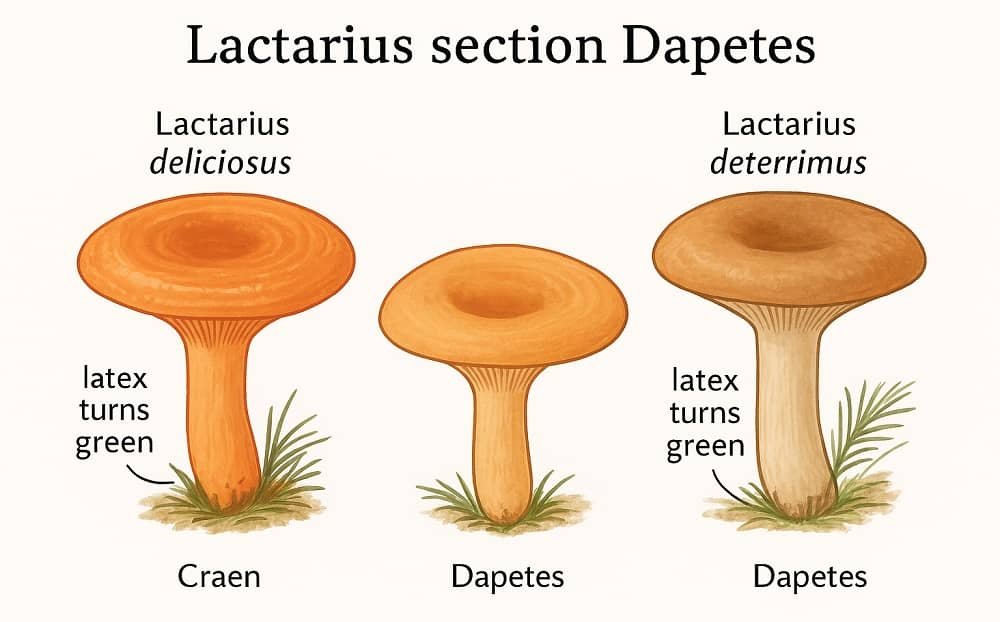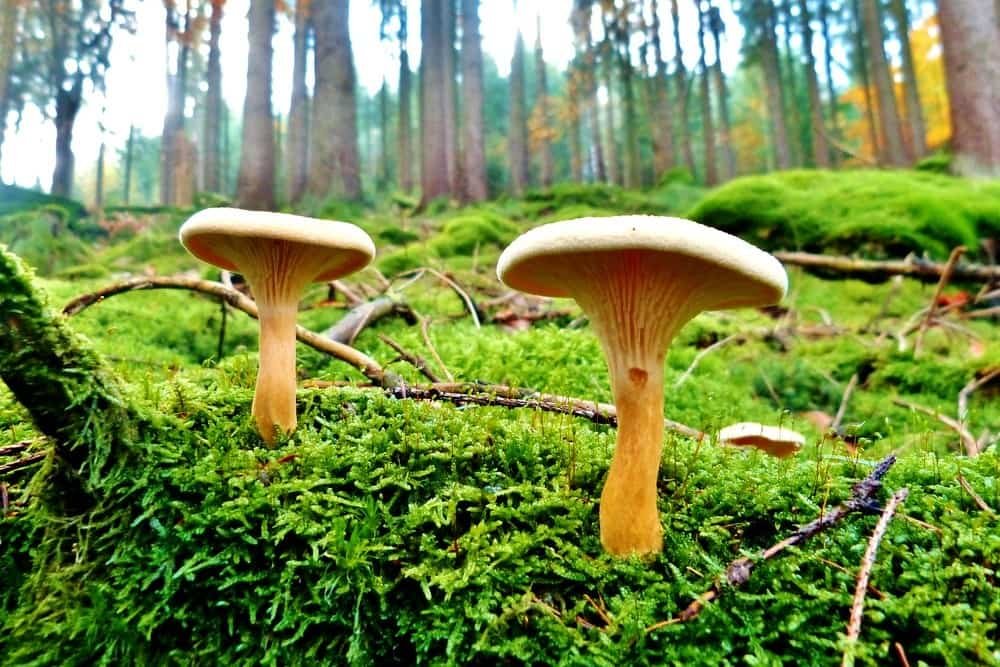When it comes to the world of mushrooms, the genus Lactarius holds a special place, particularly among mycologists and mushroom enthusiasts. Within this genus exists a unique and scientifically intriguing section known as Dapetes. This section encompasses a group of closely related species that share morphological, biochemical, and ecological traits, making it an important subject of study in fungal taxonomy and ecology. In this article, we explore everything you need to know about Dapetes—from its defining features and species to its ecological role, biochemical importance, and edible value.
What Is Dapetes?
Dapetes is a taxonomic section within the genus Lactarius, commonly referred to as milk-cap mushrooms. The term “section” in mycology refers to a subdivision within a genus used to group species that are closely related based on certain shared characteristics. In the case of Dapetes, species share specific morphological traits, biochemical profiles, and ecological behaviors.
The genus Lactarius is part of the family Russulaceae in the order Russulales. Members of this genus are ectomycorrhizal fungi, meaning they form symbiotic relationships with tree roots. This mutualistic relationship allows the trees to absorb essential nutrients from the soil, while the fungi receive carbohydrates produced by the trees through photosynthesis.
Dapetes is particularly interesting because it exhibits unique features that distinguish it from other sections of Lactarius. These include latex color changes, cap morphology, spore characteristics, and host tree preferences, which we will explore in detail.
The Taxonomic Importance of Dapetes
Understanding Dapetes is crucial for several reasons:
-
Classification Accuracy: With the large diversity of Lactarius species, sections like Dapetes help mycologists categorize species into manageable groups for identification and study.
-
Evolutionary Insights: By examining biochemical and genetic traits, scientists can infer the evolutionary relationships among species within Dapetes and their divergence from other Lactarius sections.
-
Ecological Understanding: Studying Dapetes helps researchers understand how these fungi interact with their environment, particularly their host trees and forest ecosystems.
-
Edibility and Human Use: Several species within Dapetes are prized edible mushrooms, making it relevant for culinary and economic purposes.
Key Characteristics of Dapetes
Species within Dapetes share several defining traits that make them identifiable both in the field and in laboratory studies. These characteristics include:
1. Cap (Pileus)
-
Color: Orange to reddish-orange, often with concentric zones of darker and lighter shades.
-
Texture: Viscid or sticky when wet, smooth, sometimes slightly depressed in the center as the mushroom matures.
-
Shape: Convex in young mushrooms, flattening or slightly funnel-shaped in older specimens.
2. Gills (Lamellae)
-
Attachment: Typically decurrent, meaning the gills run down the stem, although slight variations exist.
-
Color: Cream to ochre, sometimes slightly darker as the mushroom ages.
-
Spacing: Close, sometimes forked or branched in mature mushrooms.
3. Stem (Stipe)
-
Shape: Cylindrical or slightly tapering, central.
-
Surface: Often shows scrobiculation, small pits or depressions on the stem surface.
-
Color: Usually similar to the cap, sometimes slightly lighter.
4. Latex (Milk)
-
Initial Color: White in some species, orange to reddish in others.
-
Reaction: When exposed to air, the latex may turn greenish or olive, which is a key diagnostic trait of many Dapetes species.
-
Taste: Mild to slightly acrid.
5. Flesh and Cut Surface
-
Texture: Brittle and clean-breaking, typical of Russulaceae mushrooms.
-
Color Change: Often exhibits color changes when cut, especially in the presence of latex that oxidizes to green or olive.
6. Spore Features (Microscopic)
-
Ornamentation: Reticulate (net-like) or warted under a microscope.
-
Color: Cream to pale ochre in spore print.
7. Habitat
-
Trees: Most Dapetes species are found in association with conifers, particularly pines, firs, and spruces.
-
Soil: Typically in well-drained, slightly acidic forest soils.
Notable Species in Dapetes
Several species are included in Lactarius section Dapetes, each with unique traits but following the general characteristics of the section. Some notable species include:
| Species | Key Features | Habitat / Notes |
|---|---|---|
| Lactarius deliciosus | Bright orange, latex turns green | Highly prized edible mushroom; often called saffron milk-cap |
| Lactarius deterrimus | Orange cap, latex stains tissues green | Associated with spruce trees; edible |
| Lactarius semisanguifluus | Latex turns reddish before green | Pine forests; less commonly consumed |
| Lactarius salmonicolor | Paler orange; latex turns yellowish | Associated with fir trees; less well-known |
Biochemical Systematics of Dapetes
One of the most significant studies on Dapetes is the work by Nuytinck & Verbeken (2002), which focused on the biochemical systematics of the section. The study used isoenzyme electrophoresis, a method that examines enzyme variations among species, to clarify relationships within Dapetes.

Findings of Biochemical Studies
-
Species Differentiation: Biochemical data helped separate morphologically similar species that might otherwise be confused in the field.
-
Phylogenetic Relationships: Isoenzyme patterns provided insights into evolutionary lineage, showing how Dapetes species diverged from other sections in Lactarius.
-
Support for Morphology: The biochemical evidence largely confirmed the morphological classification but also revealed cryptic differences not obvious to the naked eye.
Such studies highlight the importance of combining morphological, ecological, and biochemical data to understand fungal taxonomy thoroughly.
Ecological Role of Dapetes
Dapetes species, like all ectomycorrhizal fungi, play a crucial role in forest ecosystems:
-
Nutrient Cycling: By forming symbiotic relationships with trees, they enhance nutrient uptake, especially phosphorus and nitrogen.
-
Soil Health: Their mycelium improves soil structure and microbial diversity.
-
Forest Stability: Healthy mycorrhizal networks contribute to the resilience of forest ecosystems against disease, drought, and environmental stress.
Because of their ecological significance, understanding Dapetes is not only important for mycologists but also for forest conservationists and ecologists.
Edibility and Culinary Importance
Several species of Dapetes are edible and widely consumed, particularly in Europe and Asia. For example:
-
Lactarius deliciosus: Known as the saffron milk-cap, it is harvested for its rich flavor and vibrant orange color. Often used in soups, stews, pickles, and sautés.
-
Lactarius deterrimus: Another edible species with a slightly more bitter taste; commonly found in spruce forests.
Safety Note: Not all Dapetes species are safe to eat. Some can cause mild gastrointestinal discomfort if improperly identified. Always consult an expert before consuming wild mushrooms.
Identification Tips for Foragers
If you are interested in foraging Dapetes mushrooms, here are some practical tips:
-
Look for Orange or Red Caps: Most Dapetes species have caps ranging from bright orange to reddish-orange.
-
Check the Latex Reaction: Slice the mushroom and observe the latex. A color change to greenish or olive is a strong indicator.
-
Observe the Gills: Decurrent gills that run down the stem are characteristic.
-
Inspect the Habitat: Prefer coniferous forests, especially with pines and spruces.
-
Avoid Unknown Species: Some look-alikes may be toxic, so accurate identification is essential.
Dapetes in Research and Science
Beyond foraging and ecology, Dapetes has scientific significance:
-
Taxonomic Research: Helps refine the classification of Lactarius species.
-
Biochemical Studies: Provides insights into enzyme variation and genetic diversity.
-
Evolutionary Biology: Understanding Dapetes aids in reconstructing the evolutionary history of milk-cap fungi.
-
Ecology and Conservation: Studies of Dapetes inform forest management practices, particularly in conifer-dominated ecosystems.
Dapetes vs Other Lactarius Sections
To understand Dapetes better, it’s useful to compare it with other Lactarius sections:
| Section | Key Traits | Difference from Dapetes |
|---|---|---|
| Deliciosi | Bright orange, latex often stains green | Often overlaps with Dapetes; modern taxonomy sometimes merges species |
| Russulii | White to cream caps, mild taste | Lacks orange latex reaction and typically grows in deciduous forests |
| Piperites | Acrid taste, smaller caps | Dapetes is generally less acrid and has larger caps |
| Glutinosi | Sticky caps, usually darker | Dapetes latex reaction to green distinguishes it |
Conservation Considerations
Dapetes species, like many fungi, face threats from habitat loss, pollution, and climate change. Since they are ectomycorrhizal, their survival is closely linked to healthy forest ecosystems. Conservation efforts should include:
-
Protecting mature coniferous forests
-
Monitoring mushroom populations
-
Promoting sustainable foraging practices
Frequently Asked Questions (FAQs)
Q1: What does Dapetes mean?
A: Dapetes is a section within the genus Lactarius, grouping mushrooms with shared morphological, biochemical, and ecological characteristics.
Q2: Are Dapetes mushrooms edible?
A: Some species like Lactarius deliciosus and Lactarius deterrimus are edible and prized, but proper identification is crucial to avoid toxic look-alikes.
Q3: Where can I find Dapetes mushrooms?
A: Mostly in coniferous forests, especially under pines, firs, and spruces. They are mycorrhizal and grow in symbiosis with tree roots.
Q4: How do I identify a Dapetes mushroom?
A: Look for orange or reddish caps, decurrent gills, latex that turns green or olive on exposure, and presence in coniferous forests.
Q5: Why is Dapetes important for science?
A: Dapetes species help researchers study fungal taxonomy, biochemistry, ecology, and evolutionary relationships within Lactarius.
Conclusion
Dapetes represents a fascinating and important section of the Lactarius genus. Its distinctive traits, ecological role, and edible value make it relevant not only to mycologists but also to foragers, ecologists, and culinary enthusiasts. From its characteristic latex reactions to its association with conifers, Dapetes offers a rich field of study that combines taxonomy, biochemistry, and ecology. Understanding this section enhances our appreciation of forest ecosystems and the diversity of life within them.
Whether you are identifying mushrooms in the wild, studying fungal evolution, or enjoying a meal with saffron milk-caps, Dapetes remains a remarkable example of nature’s complexity and beauty.

